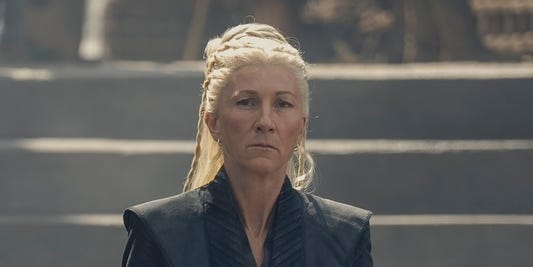Warning: Major spoilers ahead for season two, episode four of “House of the Dragon.”
“House of the Dragon” isn’t a show that pulls its punches, but its latest episode, “The Red Dragon and the Gold,” landed its most devastating blow yet.
Those who have read “Fire and Blood” weren’t surprised to see Princess Rhaenys Targaryen, the Queen Who Never Was, and her dragon Meleys fall to Aemond Targaryen and Vhagar. Rhaenys embarked to Rook’s Rest, a modest castle close to Rhaenyra’s base at Dragonstone, to meet Ser Criston Cole’s advancing force. But when she arrived, she met two dragons: Sunfyre, ridden by King Aegon II, and Vhagar, ridden by Aemond. Though she and Meleys fought until the last moment, Vhagar overpowered them, and she fell to her death.
Rhaenys’ death, as a viewer, is a tragedy. But for “House of the Dragon” to fully commit to its devastating dragon war, fought between a woman with a rightful claim to the throne and her usurper younger half-brother, Rhaenys needed to die.
Ollie Upton/HBO
‘House of the Dragon’s’ original sin is denying Rhaenys the throne
“House of the Dragon” takes place during a short period of Targaryen family history — there are a vast number of events, like Aegon’s Conquest, that precede it, and obviously, a long history that follows it (you could call some of it “Game of Thrones”). But within the context of the show, the story begins most specifically during the Great Council meeting to determine King Jahaerys’ successor.
With Jahaerys’ sons dead, the council’s choice boiled down to two options: Rhaenys, his eldest descendant, or Viserys, his eldest male descendant. Having never sat a Queen on the Iron Throne, the council chose the comparatively soft Viserys, whose decisions sowed the seeds for Rhaenyra and Aegon’s war. Rhaenys, for the rest of her life, bears the slight with grace as the Lord of Driftmark Corlys Velaryon’s wife.
Ollie Upton/HBO
But despite her acquiescence, the wrong of denying Rhaenys the throne hangs like a pall over “House of the Dragon,” and Rhaenyra especially. Rhaenys represents and espouses an old “order of things,” as she admonishes a young Rhaenyra about in season one: one where a man will always be seen as a legitimate ruler over a woman, regardless of her claim to the throne. When Rhaenyra and Rhaenys’ son Laenor are engaged, Rhaenys worries that her son will be endangered during a succession challenge. When her husband, Lord Corlys Velaryon, brings up her denial of the throne, Rhaenys says that she shuttered her ambition “a generation ago.”
Rhaenys’ persistence over the course of the series, particularly as Rhaenyra faces further challenges regarding her claim, asks an implicit question: if Rhaenys could bear not becoming Queen, why couldn’t Rhaenyra?
Rhaenys’ sacrifice represents the true beginning of the war
It feels remarkable when Rhaenys throws her weight behind Rhaenyra, though she does so seemingly reluctantly. She knows that if Rhaenyra pursues her claim, it will bring calamity. But when Alicent installs her son Aegon on the throne, Rhaenys does not bend the knee — but neither can she take the opportunity to end Alicent’s bloodline when it’s presented to her.
“That war is not mine to begin,” Rhaenys tells Daemon and Rhaenyra, justifying her actions.
At the end of season one, Rhaenys persuades her husband, Corlys, to back Rhaenyra, citing the safety of their grandchildren. But she also praises Rhaenyra’s restraint in not submitting to all-out war, which proves to be a major theme in season two. It’s Rhaenys who incites Rhaenyra’s final errand for peace: a face-to-face with Alicent, in the hopes of avoiding a war between dragons.
Ollie Upton / HBO
And when that falls through, it’s Rhaenys who must step up. Eve Best, who plays Rhaenys with a steady hand, told Business Insider that as the voice of restraint — and as Rhaenyra’s strongest warrior, astride Meleys — there was no other choice.
But thematically, Rhaenys’ sacrifice is a necessary one. As she reminded Rhaenyra in her youth, she’s an emblem of the old tradition: one in which the Queen Who Never Was must gracefully bear the insult of being denied a kingdom. No one better understands the trials that Rhaenyra faces and the judgment calls that she must make. That’s why Rhaenys makes this final decision for her, telling Rhaenyra, “You must send me.”
That decision proves that Rhaenys couldn’t — or wouldn’t — bear that insult for any longer, though she fights for Rhaenyra’s claim and not her own. Her sacrifice symbolizes an open door — one through a which a new order, however bloody the process, may be forged.
window.allScripts = window.allScripts || []; window.allScripts.push({ type: “load”, script: “%3Cscript%20id%3D%22meta-pixel-script%22%3E(()%3D%3E%7Bvar%20e%3D%7B69531%3A()%3D%3E%7Bvar%20e%2Ct%2Cr%2Cn%2Co%2Ca%3Bfunction%20i()%7Bwindow.Fenrir.cm.ccpaApplies%26%26%22ACCEPT%22%3D%3D%3Dwindow.Fenrir.cm.userConsent.OPT_OUT%3Ffbq(%22dataProcessingOptions%22%2C%5B%22LDU%22%5D%2C0%2C0)%3Afbq(%22dataProcessingOptions%22%2C%5B%5D)%2Cfbq(%22init%22%2C%221988166924554892%22)%2Cfbq(%22track%22%2C%22PageView%22)%7De%3Dwindow%2Ct%3Ddocument%2Cr%3D%22script%22%2Ce.fbq%7C%7C(n%3De.fbq%3Dfunction()%7Bn.callMethod%3Fn.callMethod.apply(n%2Carguments)%3An.queue.push(arguments)%7D%2Ce._fbq%7C%7C(e._fbq%3Dn)%2Cn.push%3Dn%2Cn.loaded%3D!0%2Cn.version%3D%222.0%22%2Cn.queue%3D%5B%5D%2C(o%3Dt.createElement(r)).async%3D!0%2Co.src%3D%22https%3A%2F%2Fconnect.facebook.net%2Fen_US%2Ffbevents.js%22%2C(a%3Dt.getElementsByTagName(r)%5B0%5D).parentNode.insertBefore(o%2Ca))%2Cwindow.Fenrir.cm.cmStarted%3Fi()%3AsetTimeout(i%2C1e3)%7D%7D%2Ct%3D%7B%7D%3Bfunction%20r(n)%7Bvar%20o%3Dt%5Bn%5D%3Bif(void%200!%3D%3Do)return%20o.exports%3Bvar%20a%3Dt%5Bn%5D%3D%7Bexports%3A%7B%7D%7D%3Breturn%20e%5Bn%5D(a%2Ca.exports%2Cr)%2Ca.exports%7Dr.m%3De%2Cr.c%3Dt%2Cr.o%3D(e%2Ct)%3D%3EObject.prototype.hasOwnProperty.call(e%2Ct)%2C(()%3D%3E%7Br.S%3D%7B%7D%3Bvar%20e%3D%7B%7D%2Ct%3D%7B%7D%3Br.I%3D(n%2Co)%3D%3E%7Bo%7C%7C(o%3D%5B%5D)%3Bvar%20a%3Dt%5Bn%5D%3Bif(a%7C%7C(a%3Dt%5Bn%5D%3D%7B%7D)%2C!(o.indexOf(a)%3E%3D0))%7Bif(o.push(a)%2Ce%5Bn%5D)return%20e%5Bn%5D%3Br.o(r.S%2Cn)%7C%7C(r.S%5Bn%5D%3D%7B%7D)%3Br.S%5Bn%5D%3Bvar%20i%3D%5B%5D%3Breturn%20i.length%3Fe%5Bn%5D%3DPromise.all(i).then((()%3D%3Ee%5Bn%5D%3D1))%3Ae%5Bn%5D%3D1%7D%7D%7D)()%3Br(69531)%7D)()%3B%3C%2Fscript%3E” });
Source link





